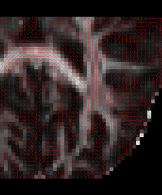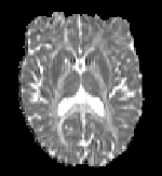



To call the FDT GUI, either run Fdt, or run fsl and press the FDT button. Use the top left drop down menu to select DTIFit.
Input: You can specify an input directory containing all the required files with standardized filenames, or alternatively you can specify input files manually by turning on the specify input files manually switch. If an input directory is specified then all files must be named as shown in parentheses below. If input files are specified manually they can have any filename. Required files are:
x_1 x_2 x_3 ... x_nVectors should be normalised to unit length. For volumes in which there was no diffusion weighting, the entry should still be present, although the direction of the vector does not matter!
y_1 y_2 y_3 ... y_n
z_1 z_2 z_3 ... z_n
b_1 b_2 b_3 ... b_n

|

|

|

|
| V1 Lines | V1 RGB | L1 | FA |
command line utility
dtifit Compulsory arguments (You MUST set one or more of): -k,--data dti data file -o,--out Output basename -m,--mask Bet binary mask file -r,--bvecs b vectors file -b,--bvals b values file Optional arguments (You may optionally specify one or more of): -V,--verbose switch on diagnostic messages -h,--help display this message --littlebit Only process small area of brain -z,--zmin min z -Z,--zmax max z -y,--ymin min y -Y,--ymax max y -x,--xmin min x -X,--xmax max x